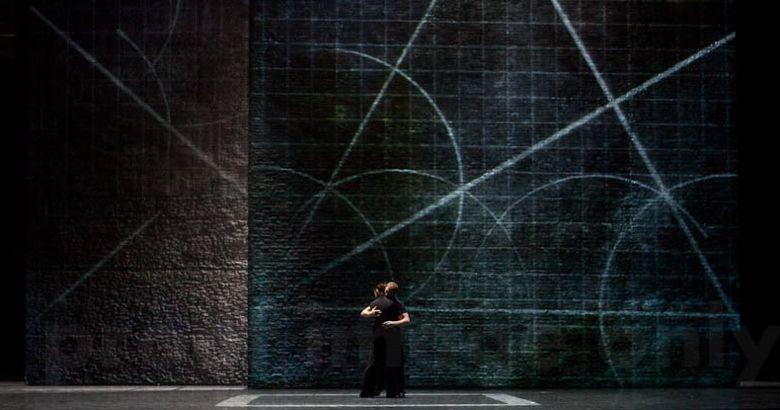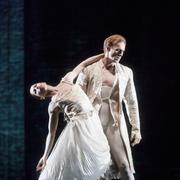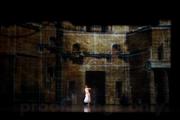Kim Brandstrup
Invitus Invitam

Related Links
This project is listed under...
Premiere
October 16 2010
Creative Team
Commissioner
The Royal Opera House
Choreographer
Kim Brandstrup
Music
Thomas Ades
after
Francois Couperin
Conductor
Barry Wordsworth
Orchestra
Orchestra of the Royal Opera House
Co-Concert Master
Sergey Levitin
Costume Design and Setting
Richard Hudson
Lighting Design
Lucy Carter
Recording of incidental music produced by
Ian Dearden
Incidental music performed by
Oliver Coates
Video Design
Leo Warner with Peter Stenhouse for 59 Productions
Notator
Amanda Eyles
Dancers
Leanne Benjamin
Edward Watson
Christina Arestis
Gary Avis
Music
Witold Lutosławski
Design
Quay Brothers
Music
Witold Lutosławski
Invitus Invitam
Critics Circle Award (2011)
Best Classical Choreography
Critics Award Nomination
Best Classical Choreography 2010
Programme Note
Invitus Invitam takes its inspiration from one line in Suetonius’s history of the Roman Emperors: 'Titus Reginam Bereniciem invitus invitam demisit', referring to Emperor Titus sending Queen Berenice away “Against his will, against her will” (invitus invitam). At the heart of Kim Brandstrup's ballet are three anguished duets for Edward Watson and Leanne Benjamin, which echo the theme of the play: the forced separation of its principal protagonists. It is set to Thomas Adès’ Three Studies after Couperin. Costume designs are by Richard Hudson. Lighting designs and video projections by Lucy Carter and Leo Warner conjure Roman palaces out of thin air.
In the preface to his play Bérénice from 1670 Jean Racine writes that the challenge to the author ‘consists in making something out of nothing’. He is referring to the fact that his entire five-act play is based on a single line from Suetonius’ history of the Roman Emperors: ‘Titus, reginam Berenicen… demisit invitus invitam.’ It means ‘Titus sent Queen Berenice away against his will, against her will’.
Read more
Reviews Extracts
Invitus Invitam takes its inspiration from one line in Suetonius’s history of the Roman Emperors: 'Titus Reginam Bereniciem invitus invitam demisit', referring to Emperor Titus sending Queen Berenice away “Against his will, against her will” (invitus invitam). At the heart of Kim Brandstrup's ballet are three anguished duets for Edward Watson and Leanne Benjamin, which echo the theme of the play: the forced separation of its principal protagonists. It is set to Thomas Adès’ Three Studies after Couperin. Costume designs are by Richard Hudson. Lighting designs and video projections by Lucy Carter and Leo Warner conjure Roman palaces out of thin air.
'The piece is small in scale, but - like the drama it recounts - massively resonant. It is superbly judged in means, in effects an in interpretations. I think it is a major acquisition.'
*****Clement Crisp, Financial Times, October 18, 2010
'Kim Brandstrup's new Invitus Invitam for the the Royal Ballet cuts between the story and the process of telling it, in a whirl of absorbing dance and computer imagery... The stage is dressed with video projections. Grids dance over the walls, turning into architectural drawings. Gaining texture and shadow, they become arches, pillars, a classical city. Dancers lean against pillars that you know can't be there. Its brilliant, but it never overwhelms the dancing.'
**** Zoe Anderson, The Independent, October 19, 2010
'Brandstrup's new work makes a poetic virtue of its own compression... Set to Thomas Ades's Three Studies from Couperin, these are passionate, fluent exchanges between Titus (Edward Watson) and Berenice (Leanne Benjamin) in which every small inflection as well as every turbulent lift comes saturated with challenge, tenderness, despair.'
Judith Mackrell, The Guardian, October 18, 2010
'It is all beautifully crafted... It is like a poem, fleeting and lovely'
**** Sarah Crompton, Daily Telegraph, October 18, 2010
'Despite its antique source, the 15-minute ballet has a modernity and emotional immediacy.'
**** Sarah Frater, Evening Standard, October 18, 2010
' The action, also as ever, is low-key, contained, rational - no scenery will ever become chewed in a Brandstrup Ballet - but if you tune into that mood, the emotion - the tragedy of a mutually regretted parting - comes over so strongly that the ending in painful to watch.'
'As ever, Brandstrup's chosen collaborators deliver a perfectly-judged background: Richard Hudson's sets and costumes, Lucy Carter's lighting and Leo Warner's videos- pure, mathematical lines and curves - combine to make a stage-picture as beautiful as anything we've seen on this stage in years.'
Jane Simpson, Ballet.co.uk, October 17, 2010
'Watson and Benjamin are superb, and Brandstrup's choreography a model of Racinian compression.'
Luke Jennings, The Observer, October 24, 2010
'The title is intensely poignant - "invitus" meaning 'against one's will' - it draws on a sparse Latin line of Suetonius, describing a king adulterously in love, unwillingly splitting with the woman he loved. Such spare plots are always Brandstrup's area of expertise, joining bare dots with his soft-limned pas de deux, urging his performers to colour them richly in with emotion... an expertly moody visual setting by Richard Hudson, Lucy Carter and Leo Warner, with video magic making castles appear and disappear behind the doomed Titus and Berenice.'
theartsdesk.com

